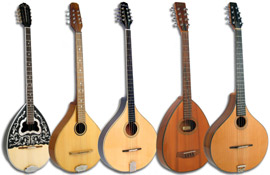| Hobgoblin Catalogue - BOUZOUKIS | |
 |
 UK & Worldwide Sales UK & Worldwide Sales
BOUZOUKI ONLINE SALES PAGE  USA Sales USA Sales
BOUZOUKI ONLINE SALES PAGE |

Bouzouki, Mandola & CitternMandolaThe big brother of the Mandolin, the Mandola retains the high-tension stringing but allows lower parts to be played. Octave Mandolas (also known as Octave Mandolins in America) are popular because of their suitability for Irish music, being tuned GDAE an octave below a Mandolin. Because the neck is shorter than a Bouzouki it is easier to finger, but the strings are heavier. The Mandola (or Tenor Mandola) is tuned as a Viola, CGDAMandocello and MandobassThe Mandocello is tuned CGDA one octave below the Mandola (however most of them will stand being tuned in GDAE like a bouzouki). The Mando Bass is a rare beast, but the examples we have had have been tuned the same as a String Bass EADG

CitternThe Cittern used by today's folk-bands has its ancestors in the renaissance Citterns and the English Guitar, but it is now more closely related to the flat-back Bouzouki - the main difference being that the Cittern has 10 strings in 5 courses, a slightly shorter neck and often a rather larger body. There doesn't seem to be a standard tuning, ADADA, ADGAD, or DGDAD, are in common use.

BouzoukiThe bouzouki was picked up by irish musicians travelling abroad and adapted for their use by retuning to GDAE. Modern makers then started producing them with flat backs which made them almost identical to the octave mandola. The crucial difference is the scale length, which is longer. This can affect fingering, but also affects sound because the strings are thinner. Generally the mandolas are better at tunes, bouzoukis for accompanying, but this is not a strict rule. Please read the rest of this article, and much more, on our FAQ page. | |